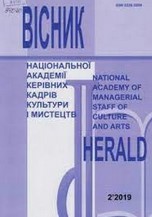ІМПРОВІЗАЦІЯ В ХОРЕОГРАФІЇ: ІСТОРИКО-ХРОНОЛОГІЧНІ ТА СОЦІАЛЬНІ РАКУРСИ
IMPROVISATION IN CHOREOGRAPHY: HISTORICAL CHRONOLOGICAL AND SOCIAL PERSPECTIVES
Author(s): Hanna Oleksiyivna Perova, Oleksandr, MaibenkoSubject(s): Theatre, Dance, Performing Arts
Published by: Національна академія керівних кадрів культури і мистецтв
Keywords: Improvisation; dance improvisation; improvisation in choreography; dance;
Summary/Abstract: The purpose of the article is to identify the essential features of dance improvisation through the historical and social prism. The research methodology is to consists of a set of methods, in particular, analytical, historical chronological, and comparative. Scientific novelty. The historical-chronological and stylistic approach for the complex definition of the concept "choreographic improvisation" is offered. For the first time, attention is focused on the emergent nature of the system of group dance improvisation based on a sociological approach to evaluating the results of individual and collective creativity. Conclusions. Improvisation as a peculiar way of artistic creativity is characterized by the quality of the process (a work of art is created directly during its performance) and the result (the form of a specific work created by improvisation). Improvisation can be found in all kinds of choreographic art, in different chronological periods and stylistic trends, in particular, in the XX - early XXI in traditional classical dance, free dance A. Duncan, postmodern experiments W. Forsythe, etc., contact improvisation S. Paxton, dance therapy practices of Alexander and Fieldenkrais, etc. Applying sociological approaches to assessing the level of creativity of improvisations (solo and group), we can conclude about the emergent nature of the group improvisation, because collective interaction during dance improvisation is not limited to a simple sum of individual creative manifestations. It was found that the number of creative ideas in solo improvisation is much higher than in pairs; there are also more of them in the trio than in pairs, but less than in the solo. At the same time, the inner state, satisfaction with the process and plastic diversity are much greater in duet and collective interaction. In general, the effectiveness of improvisation as a creative act and as an educational practice is higher in the group version. This once again explains the extraordinary popularity of contact improvisation.
Journal: Вісник Національної академії керівних кадрів культури і мистецтв
- Issue Year: 2022
- Issue No: 2
- Page Range: 142-147
- Page Count: 6
- Language: Ukrainian

